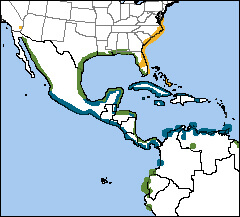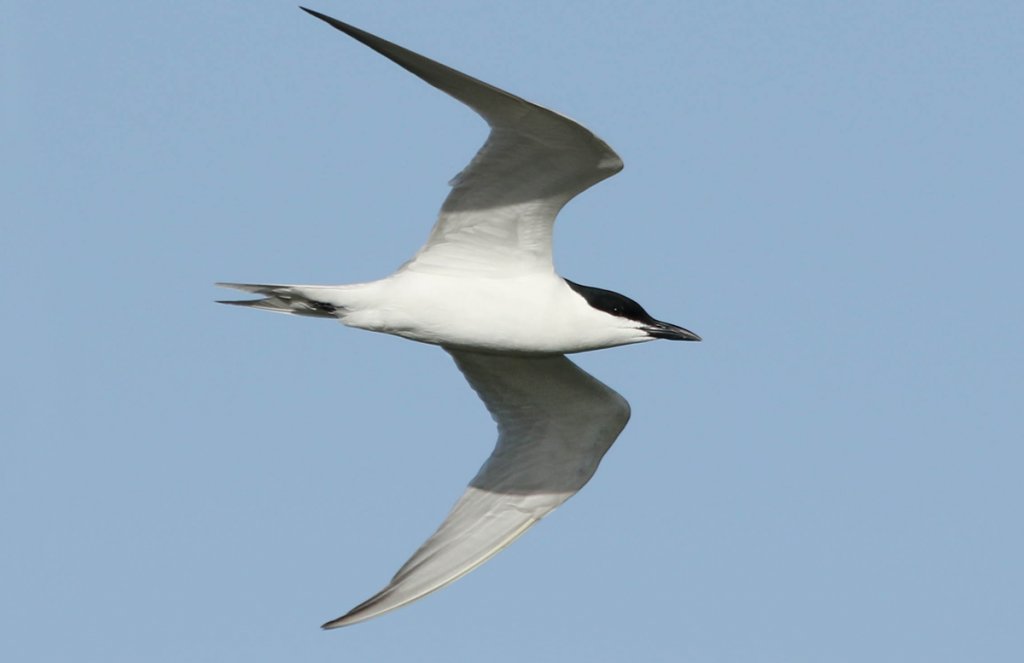
Western range of the Gull-billed Tern. Map by NatureServe.
The Gull-billed Tern is a stocky bird with wide wings, a short, notched tail, and a stout black bill, different from the slender bills of other terns such as Least Tern. Kristen Vale, Coastal Program Coordinator for ABC's Gulf Coast Birds Program in Texas, calls this species “the most un-tern-like tern along the coast.”
Like the Wilson's Plover and Black-necked Stilt, this species is threatened by habitat loss; pesticide use and human disturbance at breeding colonies are also threats.
Wide-ranging Species
The Gull-billed Tern has a worldwide range, occurring on every continent except Antarctica. In North America, the species breeds along the Atlantic Coast of the United States south of New York; along the Gulf Coast; and in southern California.
Populations breeding in the Gulf are non-migratory, sharing habitat with species like Piping Plover in winter. Those that use the Atlantic and Pacific coasts for breeding tend to winter in Florida, on the Gulf Coast, or in the tropics as far south as Argentina.

Gull-billed Terns prefer to forage on land rather than over water. Photo by Eric Kershner, USFWS
Flycatcher Tern
Unlike other terns, which plunge-dive into the water in pursuit of fish, the Gull-billed Tern is rarely spotted hunting over open water. It prefers insects and crabs, which it captures while foraging over marshland, pastures, and other open country close to the coast. The birds will also snatch up frogs; small fish, reptiles, and birds; as well as nestlings and eggs.
The Gull-billed Tern's habit of hawking insects in flight resembles the feeding style of the Olive-sided Flycatcher and other tyrant flycatchers. This behavior makes the Gull-billed Tern easy to identify.
When they do fish, Gull-billed Terns prefer to skim the surface or catch fish while standing in shallow water.
Sign up for ABC's eNews to learn how you can help protect birds
Beach-nesting Breeder
Gull-billed Terns breed primarily in dunes, on barrier islands, or in coastal marshes. Much of their courtship displays take place on the ground and involve elaborate posturing and bill-pointing; the male also feeds the female. Several pairs may nest together in a loose colony along with Black Skimmers (a close relative of terns) and other tern species.
The Gull-billed Tern's nest is a simple scrape made on a beach, dry mudflat, or in sea-wrack along the tideline. Unlike the nests of other tern species, however, the scrape is usually lined with a rim of shells, plant material, or other debris, which may provide protection from drifting sands.
The downy chicks leave the nest within a few days of hatching and take cover in nearby beach vegetation, where they continue to be fed by their parents until they are fully fledged.
Help for the Gull-billed Tern
Gull-billed Terns will nest on manmade dredge spoil islands, so habitat creation efforts could help compensate for nesting areas lost to development and sea level rise. Other effective management strategies may include fencing and signs near nesting colonies, as well as predator control.
The Gull-billed Tern benefits from ABC's conservation efforts for other coastal birds, such as the Gulf Coast Birds Program and its Share the Beach initiative. (Find out more and help!)
Donate to support ABC's conservation mission!



















































